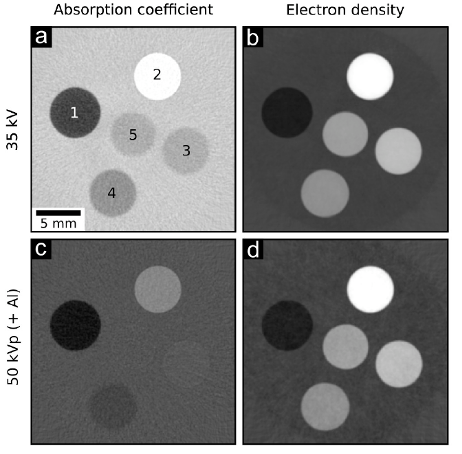Birnbacher, L., Willner, M., Marschner, M., Pfeiffer, D., Pfeiffer, F. and Herzen, J. Accurate effective atomic number determination with polychromatic grating-based phase-contrast computed tomography. Optics express, 26(12), pp.15153-15166 (2018). [http://doi.org/10.1364/oe.26.015153]
Purpose: Grating-based phase-contrast computed tomography (GBPC-CT) is an experimental X-ray imaging technique, which also allows to perform quantitative imaging. Three complementary image signals are retrieved in GBPC-CT: the conventional attenuation signal, the phase-contrast signal, which is highly sensitive to soft-tissue density differences, and the so-called dark-field signal, which reveals small angle-scattering in the sample.
Figure: Results of the phantom measurement at different source spectra. Axial slices of two scans at 35 kVp and at 50 kVp. The phantom consists of five different materials (1: LDPE, 2: POM, 3: PEEK, 4: Nylon, and 5:PMMA) embedded in a water surrounding. The absorption coefficients are displayed on the left and the electron density on the right. The attenuation coefficient is displayed linearly in an interval of [0:2; 0:6] in 1/cm and the electron density in an interval of [300; 450] in e/nm3. The experimental values presented here and in the other tables were determined as the mean of a certain volume and the respective error as the total standard deviation of the same data.
